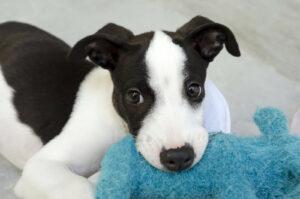Barks Blog
What Puppy Toy Next?

By Anna Bradley
If you’re anything like me, I absolutely love buying my dogs new toys. The look on their faces is pure joy and excitement when the novelty factor of a new toy kicks in – there’s nothing like it! But then they get bored after a while and are already waiting for their next toy – which duly arrives. That’s how well trained I am!
But rather than simply (and randomly) buying loads of toys on a whim, I do think carefully about what to buy, based on my dogs’ preferences, whether there are enrichment benefits, and whether my dogs will really enjoy them. So let’s have a look at this a little more closely.
Toys for Puppies – 8 Weeks to 12 Weeks
This is an approximate timeframe, but when you first bring puppy home, she needs something snuggly and comforting. Remember that she has just been separated from her littermates and mother and is suddenly facing the big old world all alone (except of course she now has you).
I like to choose a large cuddly toy to place in a crate or bed which recreates the huddle of littermates and mum, and I also provide lots of soft toys, or rope toys, or soft rubber toys because, at this time, puppy has those small, needle sharp baby teeth. I also like to give very young puppies ‘dangle’ toys as these are great to chase and satisfy the pulling, nibbling urge.
Toys for Puppies 12 Weeks Onwards
From 12 weeks, puppies begin to lose their baby teeth and require slightly harder toys to help bring the adult teeth through. So I might now add in lots of novelty chew bones such as nylon bones impregnated with flavor, or nobbly bones – anything that satisfies that chewing urge. Always check with your vet to make sure the toy is safe for your puppy.
I would also look at a puppy’s chew preference. Does the pup like to shred things in my house, chew the corners of wooden furniture or hard plastic etc.? If so I will look for toys that have a similar sort of texture.
Again, you can try different shapes of the nylon bones, harder rubber toys, tough material toys with plastic or rubber coatings etc. There’s a myriad out there, but novelty is key.
I will place all puppy’s toys in a toy box and provide maybe three per day and rotate them to keep a keen interest. It’s my personal preference not to provide antlers or bull horns etc. I know many do but I have heard too many stories of longitudinal tooth cracks and I personally don’t wish to risk this. But it’s an individual choice and again, you can always check with your vet first.
Enrichment
Enrichment should be provided throughout a dog’s life. Don’t stop just because your dog reaches a certain age and then think it’s no longer required.
There are thousands of types of enrichment toys, games, devices available. Food toys that you can stuff, items you can spread food over, games to hide treats in and so on. There are many different ways to keep your dog mentally entertained.
Outside vs. Inside Toys
I like to have a distinction between the outdoor and indoor toys. I think it’s nice to have a designated playtime outside, even if it’s just five minutes. This is great for bonding, practicing your training, improving recall skills, and impulse control. Your dog won’t even know you’re working on these skills because she’s playing and having fun!
I like to use tug toys, balls, footballs, and frisbees all in moderation. Always be mindful of your dog’s joints. Throwing and fetching and catching in the air repeatedly and then landing can place an enormous strain on your dog’s body.
Breed Instincts and Toys
Consider what your dog is bred to do and match it with a toy. Or watch their behavior to ascertain their preferences.
Is your dog a retriever? if so, practice some retrieve games with a variety of toys. You could even teach your dog to retrieve each toy by name, or hide them around the house or garden.
Got a terrier? Why not play some tug of war? Contrary to some myths, tug does not make your dog aggressive, quite the opposite in fact. You can teach great impulse control by teaching tug, with the tug contingent of the game available only upon the dog remaining calm and focused on you.
Safety
This goes without saying. Choose wisely, and remember that the cheapest toys are not always the safest. Sometimes cheap toys have loose parts, break easily, stuffing comes out quickly, bits can be swallowed, and the coloring used on any plastic may not be safe if ingested.
Never leave your dog with a toy unsupervised and throw it away if the toy is chewed too much. Has anyone really found a toy to be as indestructible as it is marketed?!
It’s so easy to be sucked in by marketing, visit the pet store and see hordes of toys and be lured into cuteness overload, but think about what your dog really needs and what function that toy could provide.
You could actually do your dog a real favor and also use your money a little more wisely.
